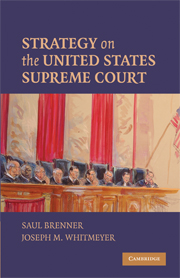Book contents
- Frontmatter
- Contents
- Preface
- PART I INTRODUCTION
- PART II CERTIORARI
- PART III THE CONFERENCE VOTE ON THE MERITS
- 6 Strategic Voting at the Conference Vote
- 7 Fluidity and Strategic Voting
- PART IV THE MAJORITY OPINION AND OTHER OPINIONS
- PART V THE FINAL VOTE ON THE MERITS
- PART VI CONCLUDING CHAPTERS
- Appendix 1 Decision Making on the United States Supreme Court
- Appendix 2 Additional Questions to Explore
- References
- Table of Cases
- Index
7 - Fluidity and Strategic Voting
Published online by Cambridge University Press: 05 June 2012
- Frontmatter
- Contents
- Preface
- PART I INTRODUCTION
- PART II CERTIORARI
- PART III THE CONFERENCE VOTE ON THE MERITS
- 6 Strategic Voting at the Conference Vote
- 7 Fluidity and Strategic Voting
- PART IV THE MAJORITY OPINION AND OTHER OPINIONS
- PART V THE FINAL VOTE ON THE MERITS
- PART VI CONCLUDING CHAPTERS
- Appendix 1 Decision Making on the United States Supreme Court
- Appendix 2 Additional Questions to Explore
- References
- Table of Cases
- Index
Summary
It is common knowledge that, at times, an individual Supreme Court justice will vote to reverse the decision of the lower court at the conference vote on the merits and will vote to affirm that decision at the final vote or the converse. In the Vinson Court era (the 1946 term through the 1952 term) and during the 1957–1967 period of the Warren Court, the individual justices switched their votes in 10 percent of the pairs of votes (Brenner, 1989) and in the Burger Court the percentage was 7.5 percent (Maltzman and Wahlbeck 1996, p. 587). There is not a great deal of fluidity in voting because “judges do not treat a vote, though nominally tentative, as a hypothesis to be tested by the further research conducted at the opinion-writing stage. That research is mainly a search for supporting arguments and evidence” (Posner, 2008, p. 110).
The question that interests us in this chapter is the extent to which the fluidity in voting constitutes strategic voting. Maltzman and Wahlbeck (1996, p. 581) conclude that
Justices are strategic actors. This is particularly evident when they change their votes between the original conference on the merits and the Court's announcement of the final decision.
Baum (1997, p. 106), however, presents a mixed picture:
Fluidity can result from strategic voting. But strategic voting may be reflected in the original conference vote. Further, changes in position can occur for reasons other than strategy. Justices may reevaluate the merits of cases on their own. … Even when justices change positions in response to interactions with colleagues, the impact of these interactions might be to provide information that clarifies the relationship between the justices' preference and the alternatives in a case.
- Type
- Chapter
- Information
- Strategy on the United States Supreme Court , pp. 59 - 68Publisher: Cambridge University PressPrint publication year: 2009



